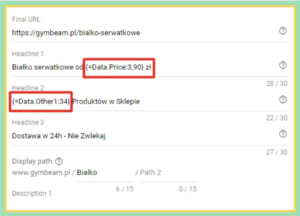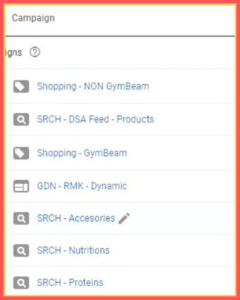How did we achieve 117.11% revenue growth for GymBeam, an e-commerce business in the fitness industry?
How to establish and optimize ROI for a fitness e-commerce brand entering the Polish market during the pandemic?
- Services
- Google Ads
- Website
- https://gymbeam.pl/
- Market
-
Poland
- Industry
- E-commerce
73.20%
increase in site traffic
117.11%
growth in revenue
28.35%
boost in conversion rates
Need a similar strategy?
Sneak peek
Our collaboration with GymBeam, a thriving fitness and eCommerce brand, presented an exciting challenge as they ventured into the Polish market during the pandemic. Leveraging our expertise in digital marketing, we focused on maximizing ROI through Google Ads.
This strategy led to impressive gains: a 73.20% increase in site traffic, 117.11% growth in revenue, and a 28.35% boost in conversion rates. Implementing Smart Shopping Campaigns and a robust influencer marketing approach, we helped GymBeam navigate a competitive landscape, greatly exceeding our ROI goals and establishing a strong market presence.
About GymBeam
GymBeam is a fitness and eCommerce portal offering dietary supplements for professional athletes and active people in general. Their offer boasts a wide variety (over 3000 items) of dietary supplements, sports nutrition, healthy foods, fitness clothing and workout accessories. All this across over 120 brands, including 4 own brands. GymBeam targets their offer to active people, amateurs and professionals alike. Their site houses products for both seasoned athletes and complete novices to the gym or sports. To facilitate their marketing efforts on the Polish market, GymBeam leverages precise data gathered through meticulously prepared site analytics, together with learnings and insights from other markets.

Establishing our cooperation
Martin, Head of Performance Marketing at GymBeam, found us on Clutch.co in February 2020. He was looking for digital marketing specialists who, like him, knew how to properly use data from analytics tools in order to drive specific marketing goals. In this particular case – using Google Ads.
When we were starting our cooperation, GymBeam was present in 8 countries, enjoying particularly good business in Czechia or Slovakia. During that same time they were in the process of expanding to other markets – including Poland.
Problems, challenges, and goals
GymBeam introduced its products in Poland, which was hit by the pandemic a mere month later. This turned consumer behavior on its head and, most importantly, dealt a debilitating blow to every fitness business, as during the next few months, every brick-and-mortar location had to remain closed.
The goal was ambitious: achieve profits as soon as possible, having one of the Top 100 Polish eCommerce companies as direct competition. At the same time, we had to deal with an emerging internet trend – a drastic surge in popularity of home workouts.
The main assumption of our strategy was to spend as much of the budget as possible on Google Ads campaigns that might potentially generate the highest Return-On-Investment.
Thus, we launched:
- Product campaigns – divided into GymBeam own brand and non-brand products.
- Search Network campaigns – targeting the most important phrases connected with product categories and DSAs (Dynamic Search Ads), based on indexed subpages and a dedicated file with product links.
- Google Display Network remarketing campaigns – targeted at customers who had added products to cart, but did not finalize purchase. Additionally, in the following months, we also ran remarketing campaigns targeted to past buyers.
Work organization
To ensure the highest possible quality of cooperation and full transparency, it was at the project’s inception that we established a call schedule with Martin. At the beginning of each month we met on video calls summarizing the previous 30 days of our efforts.
In addition, we remained in constant contact via email, going through results, campaign optimizations and any possible challenges in near real-time.
Realization
Already the first few months of the project were a harsh reality check for our initial assumptions. Consumers’ purchasing habits drastically altered in 2020, and streamlining the purchasing process became significantly more important.
In turn, search ads targeted to category keywords proved too general to generate quality traffic. At the same time, product campaigns’ performance exceeded our expectations and, especially in the case of brand products, became profitable very quickly.
Micro-managing the campaigns became a problem, though. As the amount of data grew, so did the time we needed to devote to profitability analyses of particular products or keywords. We recognized a dire need to automate our efforts, which we achieved through:
 Merging product feed with Search Ads. We have linked the product feed with Google Ads, not only for Google Shopping campaigns but also for text ads. Thanks to this, using variables, we provide up-to-date data on price, availability, and other product attributes from the store four times a day.
Merging product feed with Search Ads. We have linked the product feed with Google Ads, not only for Google Shopping campaigns but also for text ads. Thanks to this, using variables, we provide up-to-date data on price, availability, and other product attributes from the store four times a day.
- Implementing Smart Shopping Campaigns as an improved substitute of obsolete standard Product Listing Ads. As we were generating a few hundred conversions a month on this account, we could easily allow Google Ads algorithms to generate sales. As a result, we saved valuable time on working on the micro-level, which we then could spend working on the macro-level analyses. This allowed us to decide on the ROI level in every campaign.

- Implementing data about profit and ROI for every campaign as a conversion and a dedicated statistics column, right in the Google Ads panel. The client fed data about their ROI for every product directly into the page source, and thanks to that we were able to gauge the effectiveness of our marketing efforts almost in real-time. This definitely changed our outlook on measuring the efficacy of our Google Ads campaigns. From now on, we knew precisely what ROAS (Return on Ad Spend) was needed to generate profit.
Additional efforts
GymBeam themselves focused significantly on other efforts to increase sales. As our specialists were optimizing the campaigns, the client was developing blog entries, product descriptions and categories.
On top of that, they were very actively working on the influencer marketing front, cooperating with internet content creators, like Monika Kołakowska, who helms one of the biggest Polish Instagram accounts about home workouts.
Results
Almost a year and a half into our cooperation, in July 2021, we had enough data to change the main conversion on the account. We turned off conversion based on revenue and switched to optimizing towards ROI.
The results exceeded even our wildest expectations – already in October we could safely say that thanks to our efforts, the Google Ads campaigns were raking in a steady Return on Investment at a level that guaranteed profit. At the same time, spend increased by 174% and monthly orders increased by 510%
It’s easiest to see the effects through Google Analytics data. January is the hottest month for fitness, so let us compare January 2021 and January 2022. In the former, all campaigns were optimized towards ROAS, whereas in the latter all campaigns were optimized towards ROI:
- Site visitors increased by 73.20%,
- Site visitors increased by 73.20%,
- Conversion rate increased by 28.35%
All this was mainly achieved through changing the type of conversion in Google Ads. We did not set up many new campaigns on the account during this time, but focused on getting the most out of the existing ones.
This is a clear-cut case proving just how much the quality of data influences optimization opportunities and, in turn, business development.
Need a similar strategy?
Results
Monthly orders increased by 510%
Spend increased by 174%
Steady Return on Investment
Summary
What did we get out of our cooperation with GymBeam in the last 22 months?
- The world of digital marketing is inevitably marching towards gathering as much data as possible, to provide analytics tools with enough juice to effectively optimize campaigns. In our case, leveraging data about profit allowed for precisely determining the desirable level of ROI and highly efficient scaling, which was the initial goal of the client.
- Google Ads algorithms sometimes need a few months to effectively learn based on the data they are being fed. In the case of the overhaul in question in July 2021, it tooks the algorithms three months for full transition to optimizing towards ROI to take place.
- Automation becomes the foundation of marketing efforts on big accounts. Connecting data from product feeds with Google text Ads allowed us to build a full campaign structure for the future, in one action, in one tool. This gave us more time for building a successful macro-level strategy.
- You shouldn’t fret about competition, even if it’s one of the biggest players in the business and in the whole country. Developing the right strategy together with using precise data and technical expertise makes any goal achievable, even if it often takes a little time.
Need help navigating a competitive landscape and solidifying your market presence?
Let’s have a chat and see how we can apply a similar strategy for you. Just fill out your contact information in the fields below, and we’ll reach out to you within 24 hours!











